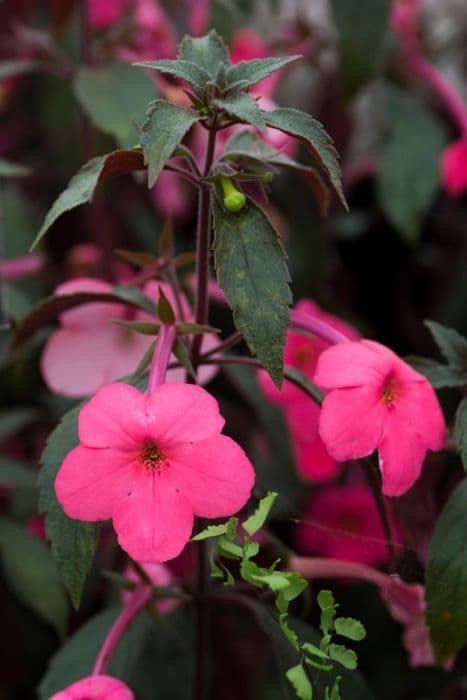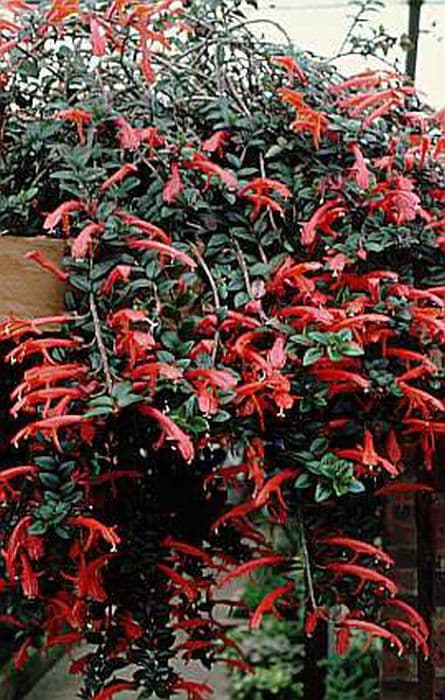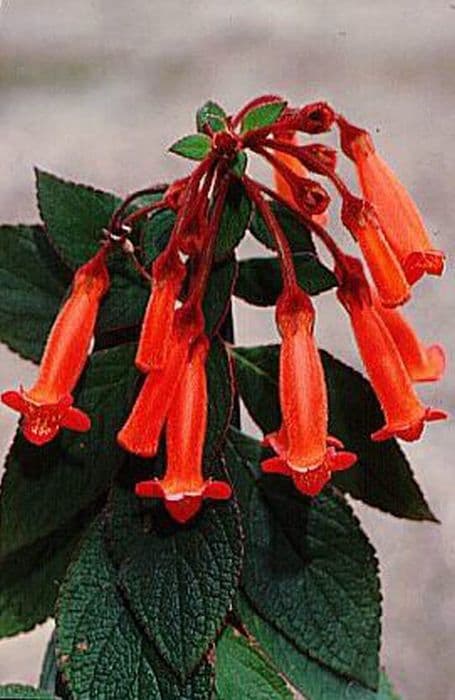Cape Primrose Streptocarpus 'Megan'

ABOUT
Streptocarpus 'Megan' is a charming flowering plant known for its striking appearance. This plant typically sports lush, velvety foliage that forms a basal rosette. The leaves are elongated and may exhibit a deep green hue, often with a soft, slightly wrinkled texture that adds to their tactile interest. The real showstoppers of Streptocarpus 'Megan' are its blooms. The flowers emerge on slender, delicate stalks that rise above the foliage. These blossoms can be described as trumpet-shaped, featuring a flared mouth that gives them an open, welcoming aspect. The coloration of the flowers is particularly captivating; they often present in vibrant shades that can range from deep purples to blues, often with contrasting throats or striking patterns that may include speckles or streaks. The overall impression of Streptocarpus 'Megan' is of a graceful, yet robust plant that brings a burst of color and soft, luscious greenery to any setting in which it is placed. Its ornate flowers and elegant leaves combine to create a visually appealing display.
About this plant
 Names
NamesFamily
Gesneriaceae
Synonyms
Cape Primrose, African Violet Cousin
Common names
Streptocarpus 'Megan'.
 Toxicity
ToxicityTo humans
Streptocarpus 'Megan', commonly known as Cape primrose, is generally not considered toxic to humans. There is no significant evidence to suggest that the plant has any toxic effects when touched or ingested. However, it's always prudent to avoid eating ornamental plants due to the potential for unexpected reactions or digestive upset.
To pets
Cape primrose is not listed as toxic to pets such as cats and dogs. However, ingestion of plant material may cause mild gastrointestinal upset in some pets due to the novelty of the material rather than any inherent toxicity. If your pet consumes a large amount of the plant and shows signs of distress, it's best to consult a veterinarian.
 Characteristics
CharacteristicsLife cycle
Perennials
Foliage type
Evergreen
Color of leaves
Green
Flower color
Mixed
Height
1 foot (30 cm)
Spread
1 foot (30 cm)
Plant type
Herb
Hardiness zones
10
Native area
Africa
Benefits
 General Benefits
General Benefits- Easy to care for: Streptocarpus 'Megan', commonly known as Cape Primrose, requires minimal maintenance, making it a suitable plant for beginners.
- Long blooming period: The Cape Primrose often has a long flowering season, providing extended periods of visual interest.
- Compact growth: Its moderate size makes it ideal for smaller spaces such as windowsills or office desks.
- Variety of colors: The blooms come in a range of colors, offering a variety of options for complementing different interior designs.
- Attractive foliage: The plant's leaves are large, textured, and often have a lush green appearance, enhancing its ornamental value.
- Indoor adaptability: Cape Primrose can thrive indoors with proper care, offering a touch of nature inside the home or office.
- Low light tolerance: It can grow in lower light conditions compared to many other flowering plants, making it versatile for different indoor environments.
- Enhanced humidity tolerance: The plant is relatively tolerant of varying levels of humidity found in typical home settings.
- Non-toxic: Safe for homes with pets and children as it is not known to be toxic when ingested.
 Medical Properties
Medical PropertiesThis plant is not used for medical purposes.
 Air-purifying Qualities
Air-purifying QualitiesThis plant is not specifically known for air purifying qualities.
 Other Uses
Other Uses- Artistic Inspiration: The vivid colors and patterns of Streptocarpus can inspire artists for painting or drawing botanical art, utilizing its unique aesthetics.
- Educational Tool: Biology teachers may use this plant to demonstrate plant anatomy and the basics of plant care to students.
- Photography Subject: Its striking blooms make it an excellent subject for macro photography enthusiasts looking to capture the intricate details of flowers.
- Horticultural Competitions: Growers may enter Streptocarpus in plant competitions, encouraging the pursuit of perfect specimens.
- Gift Plant: Due to its attractive foliage and flowers, Streptocarpus can be gifted to friends or family as a living, long-lasting alternative to cut flowers.
- Collectible Item: Plant enthusiasts may collect different varieties of Streptocarpus, including rare or unusual hybrids.
- Therapeutic Activity: The care involved in growing Streptocarpus can provide a therapeutic hobby for individuals seeking relaxation and a sense of achievement.
- Science Projects: Students might use Streptocarpus to conduct experiments on phototropism—the tendency of plants to grow towards light.
- Interior Design: As a decorative element, Streptocarpus can be used in interior design projects to add color and a natural feel to living spaces.
- Seasonal Decoration: Around blooming season, Streptocarpus can be incorporated into festive decorations due to its vibrant flowers.
Interesting Facts
 Feng Shui
Feng ShuiThe Cape Primrose is not used in Feng Shui practice.
 Zodiac Sign Compitability
Zodiac Sign CompitabilityThe Cape Primrose is not used in astrology practice.
 Plant Symbolism
Plant Symbolism- Persistence: Related to the Cape Primrose's ability to flourish with minimal care, this plant symbolizes resilience and the ability to thrive in less-than-ideal conditions.
- Hope: As a plant that can bloom in low light, the Cape Primrose is often associated with hope, representing the idea of beauty and life persisting amidst darkness.
- Longevity: Streptocarpus, with their long-lasting blooms, are connected to the concept of enduring life and are often given as a wish for a long life.
 Water
WaterCape Primrose should be watered when the top inch of soil feels dry to the touch, typically once a week. Use room temperature water, avoiding cold water to prevent shock. Gradually pour water around the base of the plant until it starts to drain out from the bottom—this usually takes about 8 to 16 ounces depending on pot size. Empty the drainage tray immediately to avoid soggy conditions which can lead to root rot. During winter months, reduce watering frequency to prevent overwatering as growth slows down.
 Light
LightCape Primrose thrives in bright, indirect light, making an east-facing window with morning light or a north-facing window ideal. Direct sunlight, especially during the hot afternoon hours, can scorch the leaves, while too little light can cause leggy growth. If natural light is insufficient, consider using grow lights to supplement.
 Temperature
TemperatureCape Primrose prefers a temperature range between 60 and 75 degrees Fahrenheit for optimal growth. They can survive temporarily outside of this range, but temperatures below 50 degrees Fahrenheit can damage the plant, and above 80 degrees Fahrenheit may stress it. Keep the plant away from drafts and abrupt temperature changes for best results.
 Pruning
PruningCape Primrose should be pruned to remove spent flowers and yellowing leaves, which encourages new growth and flower production. Prune lightly throughout the growing season as needed. The best time for significant pruning is in early spring before new growth begins, which helps to shape the plant and maintain its compact form.
 Cleaning
CleaningAs needed
 Soil
SoilThe Streptocarpus 'Megan', commonly known as Cape Primrose, thrives in a well-draining soil mix composed of peat moss, perlite, and vermiculite in equal parts. The ideal soil pH range for Cape Primrose is slightly acidic to neutral, between 6.0 and 7.0.
 Repotting
RepottingCape Primroses should be repotted every 12 to 18 months to refresh the soil and provide room for growth. It is best to repot at the beginning of the growing season in spring.
 Humidity & Misting
Humidity & MistingCape Primrose prefers high humidity levels, generally between 50% and 60%. It thrives in a well-humidified environment or a naturally humid climate but can tolerate lower levels with adequate care.
 Suitable locations
Suitable locationsIndoor
Provide bright, indirect light and keep the soil moist.
Outdoor
Grow in shade, protect from extreme temps, and keep soil moist.
Hardiness zone
10-11 USDA
 Life cycle
Life cycleStreptocarpus 'Megan', commonly known as Cape Primrose, begins its life cycle as a seed, germinating in warm, moist soil with indirect light. The seedling stage follows, characterized by the emergence of cotyledons and the development of true leaves. As it enters the vegetative stage, the plant produces a rosette of fuzzy, elongated leaves, and continues to grow in size. The flowering stage is marked by the production of trumpet-shaped flowers atop slender stems, which can occur multiple times throughout the year if conditions are favorable. After pollination, the plant can produce seed pods, completing the reproductive cycle. Eventually, as a perennial, Cape Primrose can experience a period of dormancy, particularly in cooler climates, before resuming growth and flowering in the next growing season.
 Propogation
PropogationPropogation time
Spring-Summer
The most popular method of propagation for the Cape primrose, commonly known as Streptocarpus 'Megan', is by leaf cuttings. This technique is normally undertaken during the growing season, which is spring through summer. To propagate by leaf cuttings, a healthy and mature leaf is chosen and a cut is made across the leaf, including a small portion of the main vein. The leaf is then placed on a moist potting mixture, ensuring the cut vein makes contact with the soil. Rooting hormone can be used to encourage root growth, but it is not essential. The pot should be placed in a warm, brightly lit area but out of direct sunlight, and the soil must be kept consistently moist. Roots usually develop within a few weeks, after which the new plants can be separated and potted individually.









